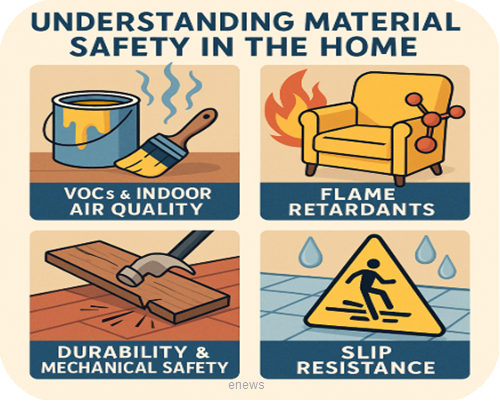When we think of household safety, especially in kitchens, bathrooms, or children’s play areas, we often focus on visible hazards: sharp corners, slippery floors, or unlocked cabinets. Yet, what’s less visible but equally critical is the science behind the materials we choose for furniture, flooring, and surfaces. From volatile organic compounds (VOCs) off-gassing from paint to flame retardants in upholstery, each choice carries hidden risks and benefits. In this guide, we’ll uncover the material science that influences your everyday safety at home.
1. VOCs and Indoor Air Quality
What Are VOCs?
Volatile organic compounds are chemicals released at room temperature from many everyday products such as paint, adhesives, carpeting, and cleaning supplies. In enclosed spaces, VOCs can accumulate, causing headaches, eye irritation, and respiratory issues.
Choosing Low-VOC and Zero-VOC Materials
Look for paints and finishes labeled “low-VOC” or “zero-VOC.” Manufacturers often provide test data to prove VOC emissions stay below regulatory limits. When it comes to flooring, vinyl-free options, like cork or natural linoleum, can significantly improve indoor air safety.
2. Flame Retardants and Fire Safety Trade-offs
The Role of Flame Retardants
Furniture foam, curtains, and electronics may contain flame retardants to meet fire safety standards. These chemicals can delay ignition or slow flame spread.
Weighing Benefits Against Health Risks
Some flame retardants have been linked to endocrine disruption and developmental effects. As a compromise, look for furniture that meets fire safety standards by design, such as using barrier fabrics instead of chemical additives.
3. Material Durability and Mechanical Safety
Strength and Stability
Material strength matters when it comes to preventing falls or collapses. For example, engineered wood boards should have consistent density and no hidden voids, while metal fittings should be rust-resistant and able to support weight without bending or warping.
Abrasion, Impact Resistance, and Lifespan
Areas like kitchen counters, stair edges, and playroom flooring benefit from materials rated for abrasion resistance—think quartz or porcelain tile. They may initially cost more, but their durability prevents hazards like broken shards, loose pieces, or exposed sublayers.
4. Slip Resistance and Surface Finish
Understanding Coefficient of Friction (COF)
The slip resistance of flooring depends on its COF, a scientific measure of how easily a surface causes slipping. Standards for bathrooms, balconies, or outdoor spaces stipulate COF thresholds.
Selecting for Safety
Choose flooring with a matte or textured finish in wet areas. Add safety with anti-slip treatments or embedded aggregates in surfaces for ramps or shower floors.
5. Chemical Treatments and Water Resistance
The Science of Sealants
Natural wood or stone surfaces often rely on treatments like penetrating sealers or coatings for water resistance. These protect from stains and moisture-induced rot or mold growth.
Balancing Breathability and Protection
A sealing agent like Etox provides a protective barrier while allowing breathability in natural stone and porous materials. Unlike surface coatings that trap moisture beneath, breathable sealers reduce mold risk while maintaining aesthetics.
6. Antimicrobial Finishes and Overuse
When Antimicrobials Help
High-touch surfaces, such as doorknobs, countertops, and shower handles, can harbor pathogens. Antimicrobial finishes (for example, silver-ion or copper-based) can help in nurseries, hospitals, or eldercare settings.
Risks of Overreliance
However, science warns against ubiquitous use: antimicrobial chemicals may contribute to resistant microbes and unnecessary chemical exposure. Reserve them for targeted use, and keep general hygiene practices as the first defense.
7. Recycled and Natural Material Trade-offs
Sustainability vs. Safety
Recycled materials like reclaimed wood, plastic composites, and insulation made from recycled fibers support circular economies. But some may contain legacy contaminants—lead paint residues, flame-retardant chemicals, or mold if sourced from damp environments.
Vetting for Quality
Always obtain certification, such as FSC for wood and Greenguard or similar for low emissions, and ask about the quality control measures for recycled content.
8. Human Factors and Ergonomics
Material Feel and Usage Comfort
Scientific studies show material texture, thermal conductivity, and bounce-back can affect human response times and risk of fatigue. Cold metal handrails, for example, feel uncomfortable and less safe than wrapped wood or composite alternatives.
Design with the User in Mind
Consider adding ergonomic grips, cushioning, or reinforcing edges, not only for feel, but also to reduce repetitive strain or impact injury.
9. Long-Term Monitoring and Upkeep
Science of Wear and Aging
Materials degrade: finishes scratch, sealants wear off, and adhesives break down. Regular inspection helps track when material performance no longer meets safety thresholds.
Scheduled Refreshes
Apply sealers every few years, re-coat finishes as needed, and replace worn flooring. These practices ensure initial safety benefits remain intact over time.
Final Thoughts
In the quest for a safer home, hidden scientific variables in materials play crucial roles: air quality, fire safety, mechanical durability, microbial control, and user interaction. Thoughtful decisions, backed by standards, testing, and transparency, can markedly reduce unseen hazards. Whether you’re renovating, decorating, or simply maintaining, understanding the material science behind indoor environments empowers you to create spaces that are not only beautiful but truly secure.
How useful was this article ?
Click on a star to rate it!
Average rating 0 / 5. Vote count: 0
No votes so far! Be the first to rate this post.
We are sorry that this post was not too useful for you!
Let us improve this post!
Tell us how we can improve this post?














